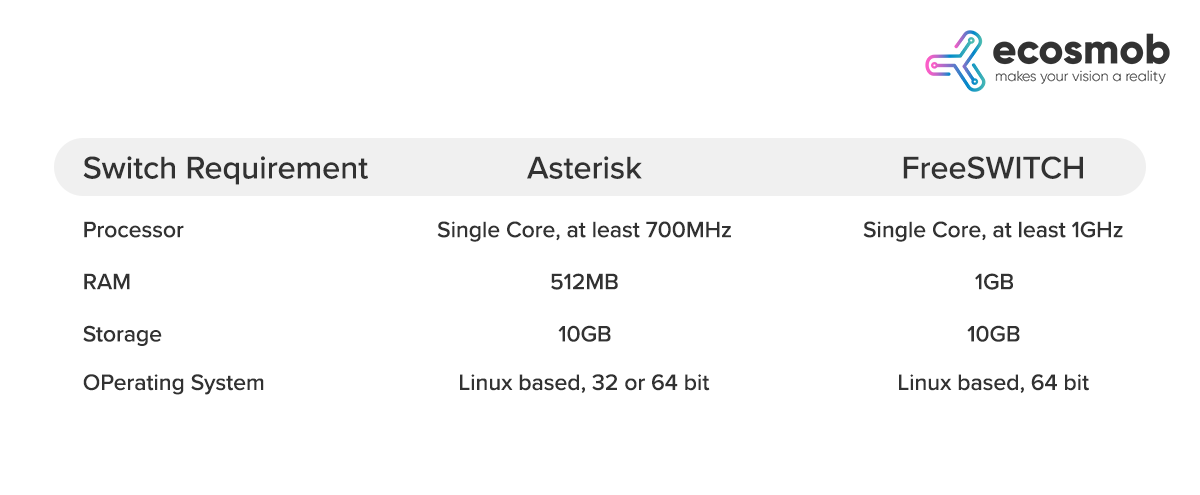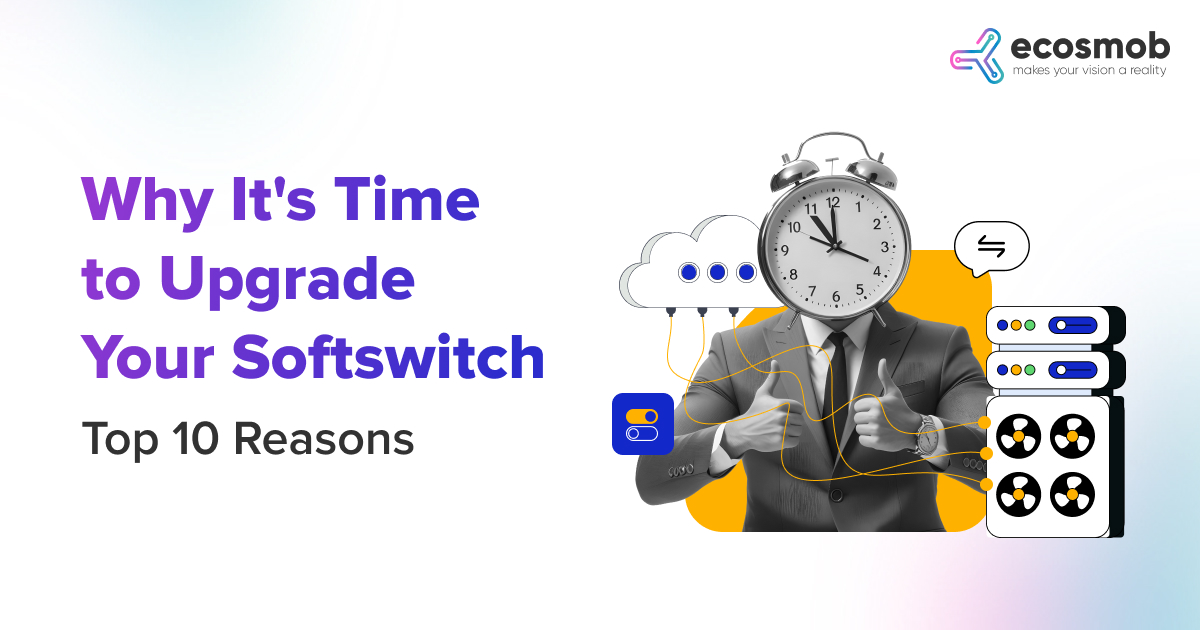For a VoIP platform, there are many options available in the market. However, out of those, two VoIP platforms are the most popular and well-known. One is an age-old Asterisk solution, and the other is a young FreeSWITCH. Both have a plethora of enterprise-friendly features for addressing business communication requirements. So, FreeSWITCH vs. Asterisk? Which VoIP platform is better?
Do not worry. Ecosmob presents an insightful comparison blog. In this blog, we will discuss Asterisk vs. FreeSWITCH at length, including,
- Hardware and Software Requirements
- Licensing
- Design
- Architecture
- Scalability
It will help you gain a clear perspective in determining which platform is most appropriate for your business requirements.
Let us start with,
What is Asterisk?
Asterisk is the first legacy software-based PBX solution. It was developed as an open-source solution in 1999 and made available for use in production in 2005 thanks to sponsorship from Digium.
Asterisk is distributed under two licenses, the GNU GPL (General Public License) and a proprietary license that enables the continued development of proprietary Asterisk-based solutions.
It offers most of the necessary features for a VoIP product. Asterisk supports cross-platform connectivity options from Voice Over IP (VoIP) solutions like SIP to traditional public switch telephony networks, PSTN, ISDN, and POTS.
With Asterisk, you can make calls within the organizations as well as outside the facility using PSTN services. Asterisk supports features like voice mail, IVR (interactive voice response), conference calling, and automatic call distribution.
What is FreeSWITCH?
Interestingly, FreeSWITCH was created by the ex-developer of Asterisk, Anthony Minessale, in 2006. The aim was to address some current issues with age-old Asterisk software. The logic behind FreeSWITCH is primarily the same as that of Asterisk. However, you can easily edit and recompile the FreeSWITCH code to meet your requirements.
FreeSWITCH is a free and open-source communication platform. It works on a sofia-sIP stack which is robust and agile. The two biggest platforms that use FreeSWITCH as their switching core are sipXcom (which began as sipXecs) and FusionPBX.
Since we understand FreeSWITCH and Asterisk, let us now compare these two VoIP platforms.
Comparison of VoIP Platforms – Asterisk vs. FreeSWITCH
1) Design
Asterisk approaches configuration and dialplan design using plain text files. It makes administration and setup easier. Asterisk uses shared resources, such as software threads during runtime, which can lead to delays when many calls come in at once.
On the other hand, the FreeSWITCH setup is based on XML, which could make manually maintaining configuration files more difficult. However, there are alternative open-source programs that might make that process easier for FreeSWITCH. Besides this, the main logic behind using XML for FreeSWITCH is to automate the task.
The main difference in Asterisk vs. FreeSWITCH design is that FreeSWITCH architects use freely downloadable open-source software libraries that carry out many necessary tasks. It is done to avoid reinventing the wheel and to lessen the complexity.
The most notable open-source software libraries are:
- Apache portable runtime
- libspeex
- libSRTP
- mod_spandsp
- SQLite
Find out Which VoIP Platform Suits Your Business - Asterisk or FreeSWITCH!
2) Licensing
FreeSWITCH is a well-known and new-age alternative to Asterisk with many of the same features—the main difference lies in the ownership model. FreeSWITCH comes with a collective ownership model, unlike Asterisk, which has a corporate model (official package) with the complexity of contributor’s agreements and licensing.
FreeSWITCH uses Mozilla Public License, while Asterisk gets distributed under the GPL. The critical distinction between these licenses is particularly for users willing to create and market their products around the soft PBX. GPL, which stands for General Public License, typically requires the user to publish the source code of any patches or other portions they develop as part of their entire solution. Digium holds a parallel-licensing system that enables the user. Users in this circumstance can use Digium’s parallel-licensing technique by paying a license fee and removing the GPL’s requirements.
In short, Asterisk is a dual licensing solution, while FreeSWITCH is free. That’s why it can efficiently handle high-volume calls due to its modular architecture.
Also Read: OpenSIPS vs. FreeSwitch: What to Choose for Scalable VoIP Deployment?
3) Hardware and Software Requirements
Since each system has its objectives, precisely measuring hardware needs can be challenging. However, to understand the hardware and software requirements, let us assume a situation. Assume PBX with up to 15 phone extensions and 5 concurrent calls.
Consider the table given below.
 As the number of phone extensions and functionality increases, the overall system performance in processing speed, memory, and bandwidth increases.
As the number of phone extensions and functionality increases, the overall system performance in processing speed, memory, and bandwidth increases.
Therefore, given the same underlying hardware and software requirements, the common consensus is that FreeSWITCH can manage a far higher number of concurrent calls than Asterisk.
4) Architecture
Asterisk has a monolithic architecture. That means the system components of Asterisk are closely knit and form one entity. On the other hand, FreeSWITCH has a modular architecture, which means developers can easily add or remove components as needed.
5) Scalability
Asterisk has limited scalability. It may not serve a higher volume of calls or provisioning calls. You may experience deadlock, data corruption, and race conditions with Asterisk. On the other hand, FreeSWITCH has a modular architecture (as also mentioned above). FreeSWITCH developers can easily add or remove components as needed.
FreeSWITCH, on the other hand, is scalable. Each call in FreeSWITCH has individual control over its resources, while the main functionality manages shared resources via a tiered API. It can efficiently handle high-volume calls due to its modular architecture.
Here is one crucial blog – Factors To Consider Before You Hire FreeSwitch Developers. It will help you jot down a checklist before you hire FreeSwitch developers.
 FreeSWITCH vs Asterisk: Which one is the Right Platform?
FreeSWITCH vs Asterisk: Which one is the Right Platform?
The answer to this question is completely based on your VoIP communication requirements.
When comparing an Asterisk switch to FreeSWITCH, there aren’t many differences in terms of functionality. Also, end users won’t notice much difference between system implementations with suitable configurations.
Asterisk is more suitable for addressing specific and traditional PBX requirements, while FreeSWITCH offers more possibilities beyond VoIP telephony. In other words, Asterisk is an appropriate tool for a conventional VoIP solution, and FreeSWITCH is a preferred choice for diverse VoIP solutions with greater freedom and scalability.
Regarding look and feel, FreeSWITCH is more appealing due to the presence of GUI (Graphic User Interface). Contrarily, Asterisk has a limited GUI and could be difficult for non-technical users.
The decision between the two platforms will ultimately be based on the project’s particular requirements and the developer’s level of expertise.















